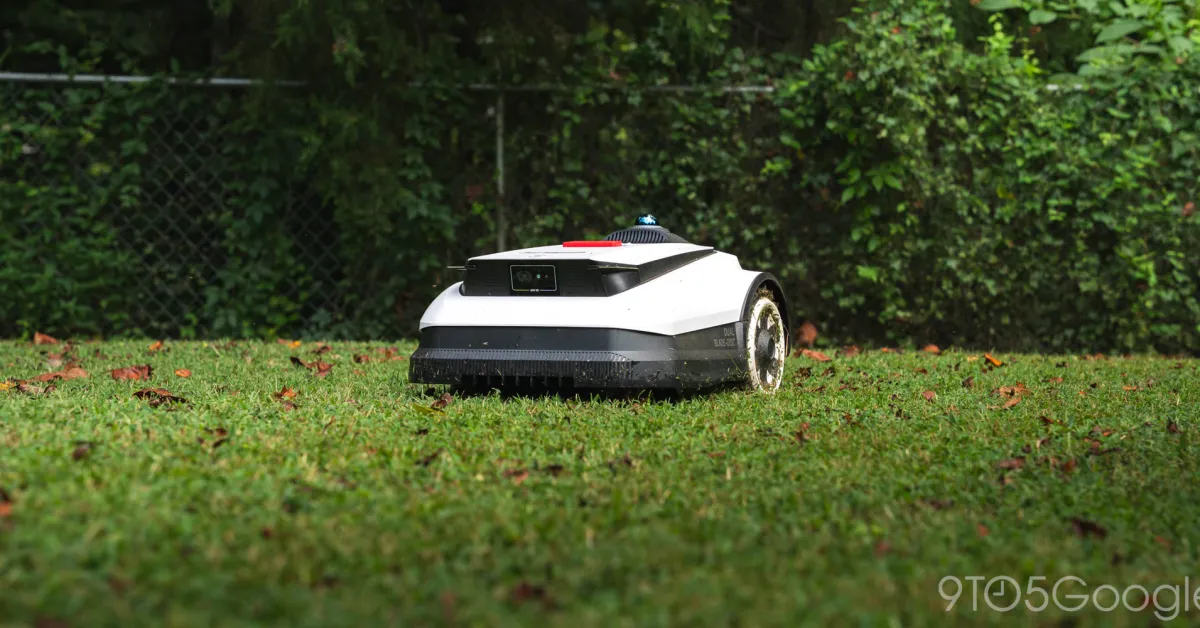Copyright 9to5Google

The natural progression of robotic home care is robot lawn mowers, because obviously it is. There are plenty of options on the market now, but the Ecovacs Goat A3000 comes from a company that knows home robots well. It doesn’t come cheap, but it’s still more affordable than getting a human to do it. There’s something of a disclaimer that needs to be said right from the start. Ecovacs’ robot lawn mowers aren’t perfect solutions to lawn maintenance. As with any smart vacuum or mop, the user needs to meet it in the middle and provide an environment for it to be hands-off. For a smart vacuum, that means picking up cords and cordoning off areas where it’s likely to get stuck. As they’ve improved over the years, that’s less of an issue. Still, it needs assistance to become a hands-off tool. The Goat A3000 smart mower from Ecovacs has the same drawback, but it’s not something I’d consider a “con.” Advertisement - scroll for more content Built like a little tank The Goat A3000 is unassuming in its design. The smart lawn mower industry is relatively new, and there have been some extreme designs roaming neighborhoods. Ecovacs’ solution is less aggressive, and it looks a little more harmless, with the actual cutting mechanics hidden below. The top of the smart mower has a dual-LiDAR array that scans at a full 360 degrees. That system allows it to create a detailed 3D map of the surrounding areas. The front of the mower carries a camera and another LiDAR sensor that brings depth data so shadows and other objects don’t disrupt map information. An LED display along the top allows for quick status information and basic settings via physical buttons. It’s useful for when the robot gets stuck, needs a restart, or if you just need to send it home for the day. The front two wheels aren’t visible, but they’re essentially rugged casters that allow the mower to traverse different terrains. The back two wheels bring the power, steering the mower like a little tank across the lawn. The wheels have a rather deep and sharp tread, but they have their limits – more on that later. The hidden portion of the robot houses two rotating blade wheels, complete with three razor blades each. They’re attached with some threadlocked Phillips screws, of which Ecovacs includes several replacements. They’re very easy to replace, and it’s something that needs to get done at least once a season, in my experience. The entire mower is IPX6 water-resistant. It can be washed with a shower-style nozzle to get dirt and debris off the top, sides, and bottom. During the wet season, it’s necessary not only for resistance to wet grass, but for the inevitable washing it’ll need when blades get stuck underneath. The rating seems to hold true. I’ve washed the Goat A3000 mower with varying strengths of water pressure, and it’s still running like day one. A docking station lets the mower charge, and it’s a simple setup. A long cord is included, so there’s plenty of wiggle room for choosing a home. Once it’s placed, the robot will place itself in the docking station to charge when not in use. It uses two surface-contacts to send power. Since the mower is water-resistant, it can placed almost anywhere. I have a shed with a covered parking area, so it lives there where it stays dry. Mapping The first thing any user will do with Ecovacs’ mowers is mapping. There are two modes: automatic mapping and manual. I chose manual because I have a pretty steep hill that’s more than the rated 27-degree incline. In manual mode, you just need to drive the mower around to create a boundary using the manual in-app controller. Automatic works well for homeowners who don’t have a ton of delicate areas to worry about. The sensors can detect grass and pavement individually, and the map will be created based on those boundaries. Where users need to be careful is when lawn items like paving stones are small enough for the robot to run over, but not big enough for it to recognize as an edge. In my first map, I included the entire backyard with just a boundary run inside my fence. Well, the shed and paved areas around it have raised concrete. It’s just low enough for the mower to try and traverse it, but too large for it to avoid the blades. At first, I made sure larger boundary stones were placed by those raised areas, to ensure the mower wouldn’t dare try. Then, I realized I could just remap the area and exclude the driveway and shed. With that, the mower doesn’t even try to get up onto the pavement, and I have to replace blades much less often! That’s where my warning comes into play. The lawn needs to be maintained in a way that makes it easy for the robot to get to where it needs to go. Yes, it has settings that control at which height objects need to be before they’re avoided, but it only does so most of the time; and if the object detection height is set too low, large patches of grass will never get cut. Fortunately, the Ecovacs app is easy to use. You can set boundaries for pathways, rock gardens, and more with no-mow zones and no-entry zones. However, you can’t set a boundary that includes the docking station. In my case, that meant I couldn’t define a paved area. That’s why I remapped, avoiding the area at all costs. If the docking station isn’t in a mapped section, the Goat A3000 mower will remember the path it took to the area, which is great if there is a very specific path the mower needs to take between lawn sections. Performance and app A good foundation between traversal capability and LiDAR arrays sets the tone for overall performance. The Goat A3000 is great at getting where it needs to go – again, if you don’t set it up to fail. The app is well-designed, as is the case with Ecovacs’ other products. It offers mowing-specific settings and additional robot settings that allow for several different things. If you’re scheduling or having it cut a lawn section, you can set mowing height by area, or you can set a general height for automatic cutting. The cut direction is also adjustable, allowing for diagonal cuts or straight paths. There’s a toggle to have the robot change the path by 90 degrees each week, which is great for the health of the grass. My grass isn’t perfect, and it’s a mix of types I haven’t determined yet. Still, the Goat A3000 does a really good job of getting it down to a consistent height and covering a good amount of space. Of course, it can edge tight corners and fencelines, so be prepared to do some weed-eating. It also can’t mow down tall, thick grass without getting stuck and redirecting all over the place. There is an “enhanced” mode that lets it carefully bring the height down on thick grass, but it’s slow and takes extra time. The key to using a robot mower is to run it twice or more a week during the summer, and once a week in the offseason. If you wait until it gets high, the Goat is going to struggle. It can also struggle in wet grass, much like a manual lawn mower. There are times when I was limited to running it once a week, and I needed to shorten the grass with a push mower first, before letting the Goat run on a consistent basis again. I also found that it sometimes got stuck in loose dirt. The wheels would spin without getting any traction, and the mower would need to be picked up and moved. After remapping and removing the weak spots from my lawn, problems dropped significantly. No Matter for your smart home While other new smart products from the same company have Matter capabilities, the Goat A3000 mower does not. That means the connection to Google Home is basic, though it isn’t without usefulness. It can be started and stopped, though it starts in auto mode. That’s not my personal preference. It can also be docked through the Google Home app. If you need to dock before you leave, or while you’re away, this is an easy way to do it. It also means commands via Google Gemini or Assistant will usually work. Battery life I was pleasantly surprised by the battery life on the Goat A3000. It uses a rotating blade disc powered by a 32V motor and can run in a quick or delicate mode. The slower mode offers better coverage and performance, and I opted to use it over the fast mode every time. At that pace, my 6,000 square-foot yard gets done in just under 3.5 hours. When it takes a break to charge, it only takes 45 minutes to get from 15% to 80% or so. From there, it can knock out the rest of the yard. Total, that’s about 4.25 hours. My front yard is a bit bigger, so I alot more time for the Goat A3000 to handle it. It still gets it done in a day with no issues. The Ecovacs Goat A3000 is rated for 3/4 acre with around 5,400 square feet every two hours. That likely accounts for the faster mowing mode, though the real-life numbers aren’t disappointing. If you have more than 0.5 acres, though, you might need to parcel out sections per week with the robot running almost daily. Final thoughts My reasoning is this: at $3,000, the Ecovacs Goat A3000 costs less in one year than hiring a crew to mow your lawn. Of course, it doesn’t do the extra detail work, but it does the brunt of it. For that, you’re saving a few hours and energy per week. The smart mower from Ecovacs has a good battery life, fast charging, and settings that set it apart from other options. It can run on its own schedule with no issues, as long as you set it up to do the job without issue. It’s not a cheap option, but it’s certainly one that saves valuable time throughout the week. It’s also one that makes your neighbors slow down to watch it run, whether you like it or not. Ask me how I know.



